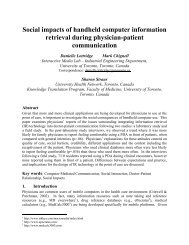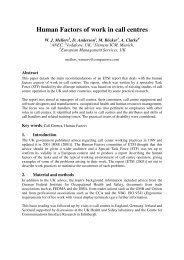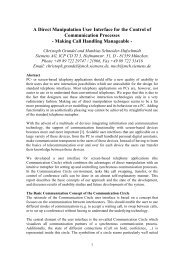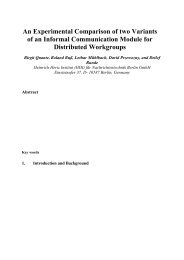Young Children and ICTs â current issues in the provision of ICT ...
Young Children and ICTs â current issues in the provision of ICT ...
Young Children and ICTs â current issues in the provision of ICT ...
You also want an ePaper? Increase the reach of your titles
YUMPU automatically turns print PDFs into web optimized ePapers that Google loves.
More generally, this raises <strong>the</strong> question <strong>of</strong> whe<strong>the</strong>r or not service providers should be told that<br />
a particular product or service is <strong>in</strong> use by a young child. For example, if <strong>the</strong>re was a<br />
requirement to make service providers aware that a mobile phone, or some web service, was<br />
be<strong>in</strong>g used by a young child, <strong>the</strong>n it would make fur<strong>the</strong>r actions by service providers <strong>in</strong> <strong>the</strong><br />
<strong>in</strong>terest <strong>of</strong> better child security easier. It could also be argued that this would protect service<br />
providers from possible legal action if it were proved that a child or <strong>in</strong>deed children generally<br />
had <strong>in</strong> some way suffered as a consequence <strong>of</strong> actions <strong>of</strong> <strong>the</strong> service provider.<br />
The technical <strong>and</strong> adm<strong>in</strong>istrative <strong>issues</strong> this raises, may, <strong>in</strong>itially at least, cause many service<br />
providers to reject this idea. Someone, <strong>the</strong> child’s parents most likely, would have to <strong>in</strong>form<br />
<strong>the</strong> service provider that a particular product or service is <strong>in</strong> use by a young child. Parents<br />
would need reassurance that such a database <strong>of</strong> child users was totally secure, <strong>and</strong> that access<br />
to <strong>the</strong> data was only by authorised <strong>and</strong> tra<strong>in</strong>ed staff. From <strong>the</strong> service providers viewpo<strong>in</strong>t, <strong>the</strong><br />
extra costs <strong>of</strong> adm<strong>in</strong>ister<strong>in</strong>g such as system might be substantial, but <strong>the</strong>y would not be<br />
prohibitive.<br />
However if we now look at <strong>the</strong> data protection considerations, it might be argued that a young<br />
child cannot be aware <strong>of</strong> <strong>the</strong> consequences <strong>of</strong> a purchase <strong>of</strong> an <strong>ICT</strong> product, or agree<strong>in</strong>g to an<br />
action which potentially allows <strong>the</strong>ir personal details to be used <strong>in</strong> <strong>the</strong> same manner as that <strong>of</strong><br />
an adults. This <strong>in</strong> turn might argue that <strong>the</strong> service provider needs to be aware that a particular<br />
customer is a young child.<br />
The general case about market forces, free trade, <strong>and</strong> <strong>the</strong> characteristics <strong>of</strong> today’s economic<br />
framework is not under discussion here. What is needed is an open discussion <strong>of</strong> <strong>the</strong> costs,<br />
<strong>and</strong> benefits, <strong>of</strong> specific actions for both sides, children as well as service providers, with<strong>in</strong><br />
<strong>the</strong> exist<strong>in</strong>g legal framework, <strong>in</strong>clud<strong>in</strong>g data protection. What must be avoided, if at all<br />
possible, is over regulation <strong>of</strong> <strong>the</strong> sector. If national adm<strong>in</strong>istrations are moved to action by<br />
<strong>the</strong> concerns <strong>of</strong> parents <strong>and</strong> parent groups, <strong>the</strong>n <strong>the</strong> <strong>in</strong>dustry as a whole will have to face <strong>the</strong><br />
consequences. This will not necessarily make children any safer. However, <strong>the</strong> consequent<br />
costs, both f<strong>in</strong>ancial <strong>and</strong> <strong>in</strong> terms <strong>of</strong> negative publicity, would be very large.<br />
8. What has been done so far?<br />
Much good work is be<strong>in</strong>g undertaken at a European level with regard to young children’s <strong>ICT</strong><br />
use. For example <strong>the</strong> EU Safer Internet Programme aims to raise awareness <strong>of</strong> <strong>the</strong> safer use<br />
<strong>of</strong> <strong>the</strong> Internet by children. There are a number <strong>of</strong> projects under this umbrella, such as<br />
INSAFE, SAFT, AWAREU 3 . The European School Net exposes many <strong>of</strong> <strong>the</strong> <strong>issues</strong> <strong>in</strong><br />
relation to <strong>ICT</strong> use by children.<br />
For <strong>the</strong> past 4 years, ETSI has been <strong>in</strong>vestigat<strong>in</strong>g <strong>the</strong> st<strong>and</strong>ardisation <strong>issues</strong> <strong>in</strong> relation to <strong>ICT</strong><br />
use by young children. Ano<strong>the</strong>r paper at this conference gives more details <strong>of</strong> <strong>the</strong> work<br />
undertaken so far. In particular two reports have been produced, TR 102 133 [ETSI (2003)]<br />
focuss<strong>in</strong>g on <strong>the</strong> <strong>issues</strong> <strong>in</strong> relation to <strong>ICT</strong> be<strong>in</strong>g used by young children <strong>and</strong> EG 202 423 ETSI<br />
(2005)] which looks at design guidel<strong>in</strong>es for <strong>ICT</strong> products <strong>and</strong> services to be used by children<br />
under 12.<br />
3 EU Safer Internet Programme http://europa.eu.<strong>in</strong>t/<strong>in</strong>formation_society/activities/sip/<strong>in</strong>dex_en.htm








